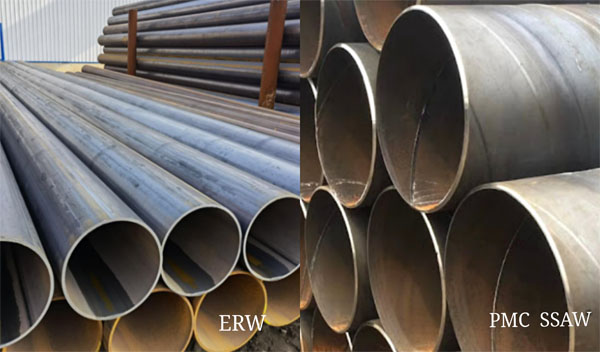
Performance Comparison of ERW and Spiral Steel Pipe
1. Overview
The welding of ERW steel pipe is the skin effect and proximity effect of high-frequency current. The process of using high-frequency current and induced high-frequency current (rising at the end of the 20th century) resistance to heat and melt the edge of the tube blank, and apply squeezing force to weld together process.
The welding of SSAW steel pipe is a process in which the weldment, welding wire and flux are melted by the arc under the flux layer, and the molten flux forms a slag to isolate the air and the molten pool from contact, thereby forming a welding joint.

There are two main differences:
A) SSAW has metal fillers such as wire flux, but ERW does not.
B) SSAW forms a weld pool, ERW does not form a weld pool, only a molten state is formed at the edge of the billet.
2. Advantages of ERW steel pipe
B)High geometric accuracy;
C) If the burr removal device is used, the weld reinforcement is lower than SSAW, and the conveying resistance is small;
D) The production efficiency is high, and the welding speed is 15-20m/min, which is more than 10 times that of SSAW.
3. Advantages of SSAW steel pipe
B) A single defect on the weld is less framing;
C) Steel strips with the same width can be used to produce steel pipes with different outer diameters, or steel strips with different widths can be used to produce steel pipes with the same outer diameter.
4. Welding performance comparison
A) ERW has fast heating speed, highly concentrated heat, and no filler metal. It is not possible to use wire flux to add alloying elements to compensate for the burning of alloy elements in the welding process like SSAW, and it cannot effectively improve the structure and performance of welded joints like SSAW (microalloying is the main way to refine grains. Grain refinement is the only way to increase strength and toughness at the same time).
B) ERW does not form a welding pool, so the welding dross ability is poor. If there is slag inclusion on the edge of the raw material, it can only remain in the weld and become a quality hazard. However, SSAW forms a welding pool, which is beneficial for slag inclusions to float in the slag.
C) There is no slag/gas protection during ERW welding (SSAW has slag protection formed by flux), and the welded joint structure at high temperature is easily oxidized, which makes the welded joint have a tendency to embrittlement.
D) ERW has the characteristics of high local heating temperature and short cooling time. The welding temperature field has a large gradient, which is prone to hardening phase and large welding stress. The plasticity and toughness of the welded joint are not ideal. Therefore, all ERW steel pipes in the country require post-weld heat treatment (Q+T or Q+N), but the domestic post-weld heat treatment process is not yet mature.
E) Compared with SSAW, the ERW welding speed is too fast, the edge quality of the raw material cannot be tested by NDT, and the NDT test of the weld after welding is also difficult to ensure the quality.
F) Since ERW is welded by pressing molten metal, it is difficult to use NDT for effective inspection. Therefore, incomplete fusion and gray spots are the problems of eRw steel pipes, which have been difficult to effectively solve for decades. Groove corrosion in ERW pipeline failure is mainly caused by unfusion.
H) The residual stress of traditional SSAW pipe is relatively large, and the dimensional accuracy is not as high as ERW. (In fact, the residual welding stress of ERW is also relatively large, of course, a part of it can be eliminated if proper heat treatment can be performed). Nowadays, advanced technologies such as low residual stress forming and mechanical expansion of pipe ends are commonly used for the production of SSAW pipes, and the quality is not much different from LSAW.
I) Since ERW has no filler metal, there is almost no reinforcement, which is conducive to FBE or 3PE anti-corrosion treatment. SSAW steel pipe has high welding seam reinforcement, and anti-corrosion requires high welding seam shape. Pay attention to the sudden transition between the welding seam and the base metal, forming a right angle or an acute angle. SSAW steel pipe factory generally adopts external welding double wire welding, the front wire guarantees the penetration, and the rear wire mainly guarantees the shape of the weld to achieve a smooth transition. Judging from the steel pipes produced by our factory, there is almost no right angle or acute angle.


